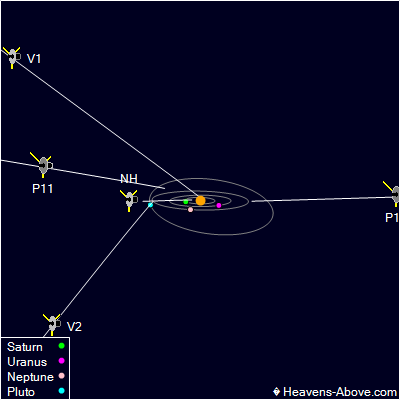THE SOUTHWORTH PLANETARIUM
207-780-4249 www.usm.maine.edu/planet
70 Falmouth Street Portland, Maine 04103
43.6667° N 70.2667° W
Altitude: 10 feet below sea level
Founded January 1970
Julian Date: 2458865.16
Julian Date: 2458865.16
2019-2020: LXXXVI
THE DAILY ASTRONOMER
Thursday, January 16, 2020
Voyager's Billion Year Voyaging

Voyager 1, the most distant human-made object from Earth, is moving away from the Sun at 17 kilometers per second (slightly more than 38,000 miles per hour.) Launched in September 1977, this robotic emissary is already more than 148 times farther from the Sun than Earth. Light from the Sun requires nearly 21 hours to reach the probe it feebly illuminates. Designed to study the outer planets, the Voyager 1 probe has now infiltrated the heliosphere and is moving inexorably into the wide gulfs of interstellar space.
How far will it go?
How long will it last?
Will it exist indefinitely?
Those were the intriguing questions a patron posed to us a while ago after one of our presentations. (We had mentioned that the Voyager 1 craft was well concealed within the dark hollows of the constellation Ophiuchus.) We displeased the patron somewhat by conceding that we had no means of telling how long it would last or how far it would venture or even how long it would continue to exist. Sometimes science doesn't provide the specific answers people prefer. Instead, we can only speak about probabilities based on the knowledge we have. In this way, science is exactly like life.
We know that the Voyager I craft will continue moving at more than 30,000 miles per hour for quite a long time because it will encounter no impediments, provided it doesn't run into one of the many careening objects loitering about the outer solar system. Those these objects number in the billions, the space separating them is so vast the probability of any such encounter is vanishingly small. We also know that it will come within 1.7 light years of the star AC +79 3888 in about 40,000 years. This approach certainly isn't close and as its equipment will be shut off completely in 2025, it will transmit no data from the system, even if it did wander close enough to gather any. Voyager I will be a silent, dark, lifeless machine gliding through the galaxy. Newton's motion law tells us that Voyager I will neither decelerate or accelerate unless an external force acts upon it. In theory, it could be captured by a planet or even a star provided it ventures in close enough. Otherwise, Voyager I's odyssey through the Milky Way will continue for millions, if not billions of years.
The Voyager I probe, like its counterpart Voyager II, as well as Pioneers 10 and 11 and the New Horizons vessel,
will be like bottles tossed into the boundless cosmic ocean: evidence of our existence that might go utterly unnoticed
in the galactic void.
To subscribe or unsubscribe from the "Daily Astronomer"